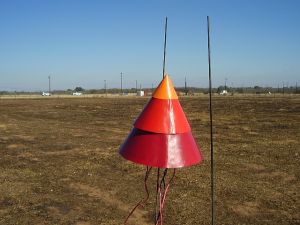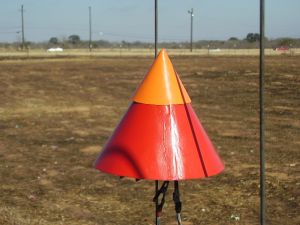Art Applewhite Rockets 3-Stage Cluster Cone (Plan)
Art Applewhite Rockets - 3-Stage Cluster Cone {Plan}
Contributed by John Lee
| Manufacturer: | Art Applewhite Rockets  |
Brief: Some time ago, Art Applewhite gave me one of his 13mm Qubit rocket kits at an Alamo Rocketeers launch. It has worked great ever since and while the "saucers" don't exactly appeal to me aesthetically, they have found their place in my grand scheme of thing because the field I usually fly in is small. That makes clusters and staged rockets problematic...except for this one. It is tailor made for my field. Construction: This one turned out to be harder than I expected right from the beginning. Art Applewhite provides a .PDF of the templates at his website. So far, so good. When really studying the thing though, I realized several things. First, there are no instructions. You have the templates for the shrouds and foam board but then you just have to look at the photos on EMRR and figure it out. Second, not all of the drawings in the PDF are full scale. Some are and its just a matter of printing them out on the proper cardstock, but others are produced at 50%. Art thoughtfully provides the radii needed for the larger shrouds. Since I am a lousy manual draftsman, I started an Autocad file and was quickly able to reproduce the needed templates in a DWG file. Then it was just a simple matter of printing it out. That's when I learned of the second problem with my approach. The largest of the needed shrouds was just a touch bigger than would fit on 11" x 17". I had to print it in two parts with some match lines and hope I got it right. I decided that starting with the third and smallest stage would be the logical place to start. I was able to cut out the shroud, motor mount, and aft bulkhead without any problem. The stock I used was a bit stiff, but I still had little problem forming the cone. The aft bulkhead was a bit more finicky and I decided that it would be best to make the motor mount to makes sure everything fit. That seemed simple enough. I just had to roll the stock for the mount into a tube, and I assumed, glue along the appropriate line to form a tube. I rolled the tube and something looked wrong. When the lines matched up, the hole looked too small so I grabbed a spent 13mm casing and sure enough, don't trust the match line. With that in mind, I rolled the motor mount around the casing and glued it together. Now all I had to do was wrestle these three components together so that the launch lug holes lined up. I managed to do so...eventually. With that, the upper stage was done. The next thing I decided I had better get done was the application of the templates I had produced with Auto CAD onto the poster board. I was not happy with the poster board I found at Wal-Mart. It seems much lighter than the poster board I remember in school. Since I had made the upper shroud with some glossy paper analogous to that used in rockets like "The Point" and "Vulcan", I went to my local paper distributor to see if I could get it in large sizes. I was in luck. The had 3 poster size pieces in the right weight just sitting around from a broken packet and gave them to me! With the poster board and templates in hand, I joined them together with 3M's 77 adhesive and set it aside to dry. It was time to work on the 2nd stage. There are actually 3 shrouds to cut out for the middle stage in addition to the motor mount which needs to be cut from heavy stock as well. Remembering the problem with the upper stage, I used a spent 18mm casing to test the match line. In this case, it worked perfectly. The paper motor mount wrapped around the spent motor and the tip of the outside reached exactly to the indicated line. A little white glue set it up and allowed me to get to work on the body. The body consisted of 3 shrouds. I will refer to them as the outer (the part you see), the upper (fits in the interior near the top) and the lower (forms an aft bulkhead). I cut the upper and the lower out with a razor knife without any problem. The upper involves no creasing and was easily formed. I did the forming around the motor mount to make sure the fit was right and then glued the tab. The lower shroud needed to be creased along 2 arcs. I used a ballpoint pen and pressed down heavily along the dashed lines. I found that after doing so, the shroud was easily bent into the proper position. I again formed it around the motor mount. The result looks something like a smashed letter "M" in cross section with the center peak truncated. The outer shroud was cut from the poster board I had gotten for free because it was too big for tabloid sized paper. I had glued the template on and allowed it to dry. It cut out easily and was again creased with a ballpoint. It too bent into shape easily using the motor mount as a guide. Assembling the 3 shrouds together though was less easy. My problem was getting the motor mount through all three pieces and then getting them to line up right with the launch lug holes. I used a short piece of 1/8" rod for alignment along with the motor mount. I found that fits which had been "good enough" were no longer good enough. The trouble seemed to be the evenness of the central core through which the motor mount was to slide. Some "flashing" was in the way. After an interminable exercise with the razor knife, I used some 120 grit sandpaper to smooth things out. After that, the mount slid in much more easily. Then it was a matter of getting everything aligned and applying the glue. The motor mounts for the first stage were much like that of the second. I used a spent 24mm casing and wrapped the cardstock around it. Like the 18mm mount, I found that the match lines worked perfectly. The shroud for the first stage was also easy. It was simply a matter of cutting it out since there is only one and then gluing along the line. Instead of using interior shrouds for support, this stage uses foamboard. The templates for the foamboard had already been applied. I used a fresh blade on the razor and cut around the outer edge. The templates also have a circle marking the inner edge. The foam has to be cut at an angle to accommodate the cone shape of the rocket. I found that cutting along the outer line as a cylinder worked best. When the outer profile was completely formed, I then took the razor knife and shaved around the edge to put in the proper bevel. The upper bulkhead slid into place easily. I used some weight to hold it in place and applied a bead of white glue around the circumference. When that was dry, I inverted the stage and put a bead around the forward edge as well. The aft bulkhead cut out just fine but I ran into problems as I was trying to test fit everything. The motor tubes were a tight fit, both in the bulkhead and around the motors. I decided at this stage to substitute 24mm body tubes for the paper tubes. I cut some BT-50 to length for the motor tubes of the 3rd stage and then everything started to work out well. I glued them together in parallel, and when dry, I test fitted them. Everything slid into place so I installed the aft bulkhead and glued the works into place. I placed a fillet of white glue around the intersection of the aft bulkhead and shroud and let the assembly dry. PROs: not too difficult for a 3-stage cluster CONs: making everything keep its shape while working with it Finishing: Not being very original when it comes to artwork, I painted the first stage red, the second stage a brighter red and the third stage orange. That too could have looked better. It was time to see how this beast works. Flight and Recovery: It went straight up, spinning unexpectedly, and then staged perfectly. Both sections recovered without a scratch. There was just some minor scorching on the bottom of the upper stage and that was expected. Now it was time to try the full stack! The outboard motors were Estes D12-Ps. The central motor was a D12-0. I wimped out and used a B6-0 in the second stage and then the top got another A10-PT. It took a little wiggling to get everything lined up but again was not too bad. Again, almost anything would have been forgiven after launch. Upon first pressing the button, nothing happened. I waited a little bit and then check things out only to find that one of the clips from my whip was grounded out on the rod. I fixed that and tried again. WHOOOOOOSH! It went off like a dream. It weathercocked a little bit but everything seemed to work perfectly. I remember being bitterly disappointed that I wimped out with the B6-0 and wishing that I had used a C6-0 instead but the B performed as it was supposed to and they all come down in bounds. A quick check showed that all motors had ignited. There was a little bit of tearing in the first stage but that was of the paper I had printed the pattern on. The cardstock was unaffected. PROs: It worked, it landed in bounds CONs: None Summary: CONs: non-traditional shape, burns up motors quickly
3 stage cone rocket, 3 x 24mm first stage cluster, 18mm second stage, 13mm sustainer, and aerobrake recovery.
The basic material consist of foamboard, cardstock and that's about it. I "cheated" and used some BT-50 for the first stage motor tubes. I opened the file in my copy of Adobe Acrobat Professional with the plan of simply printing the pages in question out at 200% on my big printer that handles 11" x 17". That produced two more problems. Acrobat only gives "full size" and "scale to fit". I could not generate 200% pages directly so I fell back on plan B.
I opened the file in my copy of Adobe Acrobat Professional with the plan of simply printing the pages in question out at 200% on my big printer that handles 11" x 17". That produced two more problems. Acrobat only gives "full size" and "scale to fit". I could not generate 200% pages directly so I fell back on plan B.
I did not like the shroud overlap so I decided to try to minimize it by using Elmer's Fill ‘n' Seal to fair out the transitions. I applied the stuff and then sanded it down. It did improve things, however, I did a rushed job of it in order to be ready for a club launch. It could have been much better.
On Art's advice, I started modestly with just the 2 stage version. I put a C6-0 in the booster and an A10-PT in the sustainer. It was a bit tricky getting the holes aligned on the launch rod but they were together without any major headache. Even if it had been a major headache, all would have been forgiven after the launch. It was great.
PROs: 3-stager able to be flown from small fields, cluster able to be flown from small fields, it works
Sponsored Ads
 |
 |











